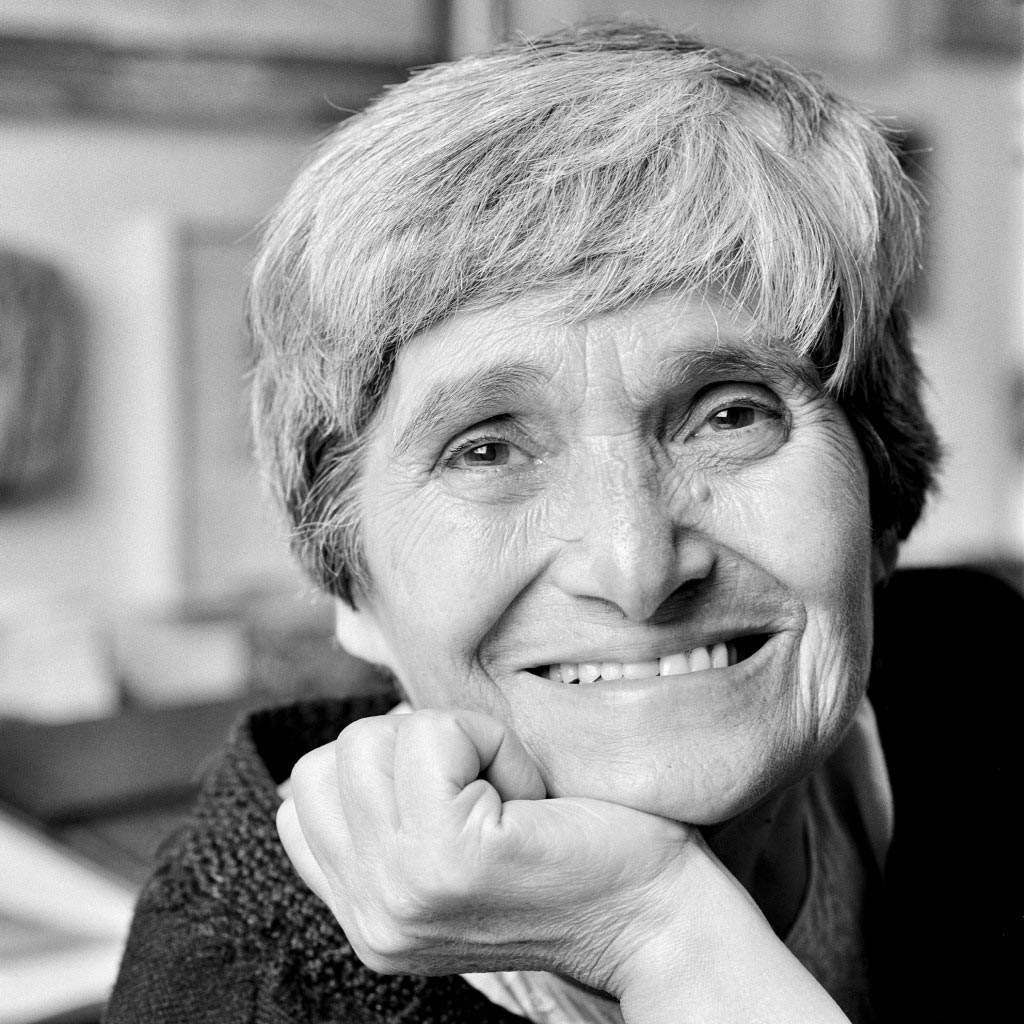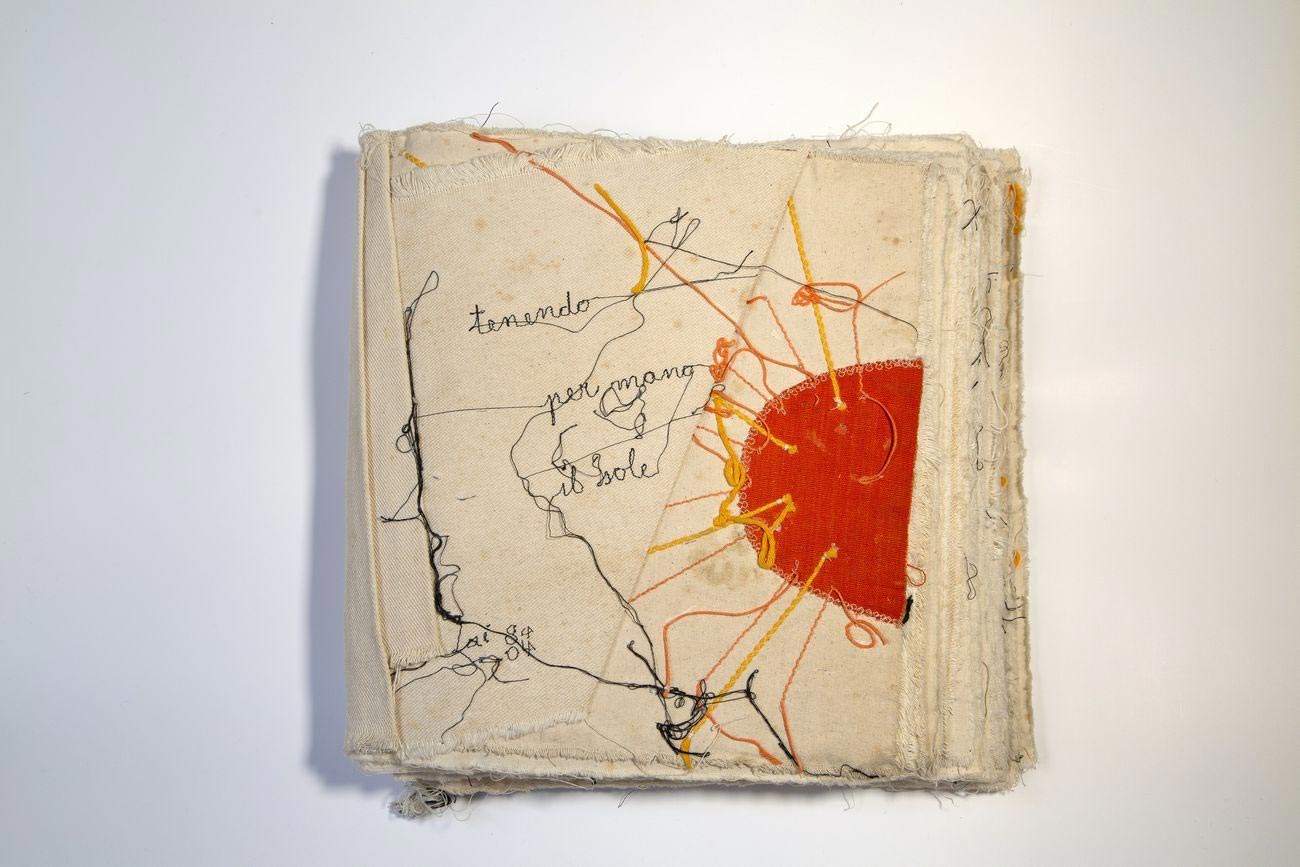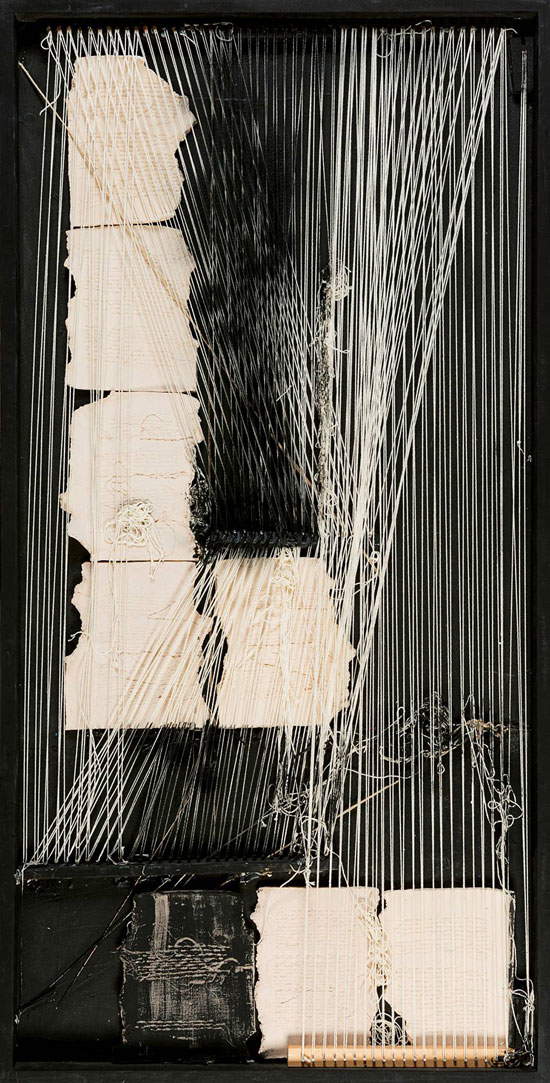Maria Lai (Ulassai, 1919 - Cardedu, 2013) is a well-known artist best known for her textile works, defined by critic Giorgio Di Genova as a poetic amanuensis of sewing. Her artistic technique, in fact, revolves around the use of textile materials that refer to the past of her land and the ancient traditions of Sardinia. Her art is connected to elements such as tradition, waste, and weaving. The artist’s most representative and well-known work is Legarsi alla montagna (1981), an art event held in Ulassai in 1981 over a three-day period.
Her story and person represent a symbol of women’s emancipation in that she was able to transform what should have been the ordinary (such as work at the loom or in the kitchen) into her art, thus managing to escape from an already written future. Speaking about her life, she said, “I since childhood always needed to escape from home and was looked at with a questioning, ’Don’t we love you enough? Why do you always stay away? Why are you always hiding?’ I really loved being alone, hiding, and they would say, ’What are you doing?’ And I would listen to the silence. It felt beautiful to me. But of course I felt different, I always felt a little bit accused, I always seemed to be betraying those who loved me. And always I had the need to create distance between those who love me and me. I can’t stand to be loved more than that. True love is what my father gave me by helping me to be free even while being worried about me.”
Although close to the Informal group, thanks to some common themes, Maria Lai does not take sides and acts on her own with a wholly singular background of experience and lived experience, impossible to associate with any movement. In her works, Maria Lai talks about herself and the female labor of her land. Maria Elvira Ciusa, her former collaborator, said about it, "The world of the arts, when she made her debut, was dominated by men...Maria Lai was assailed by the discouragement of having to continue to struggle and find herself living in the shadow of her fellow travelers, with whom she had shared in the 1960s the new languages of art, of artists such as Pino Pascali, Jannis Kounellis, Piero Manzoni and Alighiero Boetti."
 |
| Portrait of Maria Lai. Ph. Credit Pietro Paolo Pinna |
Maria was born on September 27, 1919 in Ulassai, a small Sardinian town in the Ogliastra region, to one of the few wealthy families in her land. During her childhood due to health problems she spent the six hottest months of the year in Ulassai and the remaining ones in the plain of Gairo at her relatives’. Spending the winter months at her aunt and uncle’s house where the air is more salubrious, she begins to discover a passion for drawing that helps her escape from the dullness and flatness of her days. In 1928 her uncle decides to take his own life in prison after being falsely imprisoned following a murder charge for shooting his neighbor. From that time, Maria also began to spend the winter months in her hometown until 1932. Unfortunately, her uncle’s suicide was not the family’s only bereavement, as, in 1933, her sister Cornelia also died. Despite the tragic year, she had the opportunity to visit the studio of artist Francesco Ciusa, whom she asked to pose as a model to depict a portrait of her late sister. It was here in his studio that she first became interested in and approached art, being impressed by it. Years later her parents decide to enroll her in middle school, after skipping kindergarten and elementary school. At school she meets writer and teacher Salvatore Cambosu, who introduces her to the world of words. Although not inclined to writing, she is interested and fascinated by the value and rhythm of words, which leads to silence.
In 1939 a crossroads presents itself before her: on the one hand the destiny her parents would like her to have with a marriage and children and on the other her desire for independence.
Her love of freedom led her to move to Rome to continue her studies at the city’s Liceo Artistico. During these years, she further refined and increased her artistic techniques, which allowed her to be noticed by teacher and sculptor Renato Marino Mazzacurati, who saw in her a particular talent. After finishing high school, with the outbreak of war, she moved to Venice where she attended the Academy of Fine Arts. Here she has the opportunity to have as a professor the sculptor Arturo Martini who lectures on emptiness, shadows, and the volume of stone, thus influencing her way of producing and viewing art. After graduation and with the end of the conflict in 1945 she returned to Sardinia where she continued her association with Cambosu, her former literature professor: for the first time Maria had the opportunity to illustrate a book cover, in this case that of Miele Amaro (1954). The same year, again Cambosu introduced her to the solo exhibition in Sassari and she was invited to participate in the group exhibition L’arte nella vita del Meridione d’Italia at the Palazzo delle Esposizioni in Rome. The following year, in 1955, she organized her own solo exhibition in Bari and participated in the Quadriennale in Rome, where she exhibited alongside the works of Lucio Fontana with his famous spatial concepts and the works of Alberto Burri with his Sacchi . Also in 1955 her younger brother died following a kidnapping: from that moment Sardinia did not become a safe place for her and so she decided to move later, in 1956, to Rome. In 1957 at, the gallery L’Obelisco, she held a solo exhibition featuring for the first time drawings made in pencil from 1941 to 1954. Immediately after the exhibition he decided to open his own art studio.
There followed a period of profound silence where for about ten years he withdrew and decided not to exhibit again, concentrating on new experiments. He shifts here from figurative to informal where his signs become more essential. In this phase of silence he begins precisely to produce works to date among the best known such as Canvases and Stitched Books, Lo aves and Looms.
Thanks to the writer Giuseppe Dessì, his friend and writer, he discovers the true value of his homeland by grasping the sense of myth and legend. Visiting Canada with Marcello Venturoli he comes into contact with primitive art from which he draws inspiration for the making of his ceramic masks. In 1971 he returned to the scene with a solo exhibition at the Schneider Gallery in Rome where he exhibited his Telai, strongly inspired byArte Povera. These were the most significant years for his artistic career, during which he produced polymateric works and with bare materials such as ready-made looms or bread sculptures reminiscent of the ancient traditions of his Sardinia. In 1975 she exhibited her solo show Tele e Collages at the Art Duchamp Gallery, and in 1977 at Il Brandale Gallery in Savona she organized the exhibition I pani di Maria Lai. Due to the success of the exhibition, curator Mirella Bentivoglio decided to exhibit it at the Venice Biennale in an exclusive exhibition dedicated to the artistic production of women only.
In the 1980s she produced the Geographies series of works and the Stitched Books series. She also produced numerous public works, the best known of course being those in Sardinia in Ulassai. In the 1990s there is a close connection in her art with her earlier works which feature sign-designs that go together with the loom threads or productions called Geographies . Maria Lai spends the last years of her life she spends in Sardinia in a small village near Cardedu. In 2006 she opened the Museum of Contemporary Art Stazione dell’arte that includes numerous works of her own creation, the result of years of study and research. In his later years he achieves success not only in Italy but also in the world where he takes part in multiple art exhibitions. She died in Cardedu on April 16, 2013.
 |
| Maria Lai, Bound to the Mountain (1981) |
 |
| Maria Lai, Holding hands with the sun (1984-2004; thread, fabric, velvet, 33 x 63 cm; Private collection). Ph. Credit Francesco Casu |
 |
| Maria Lai, Telaio del meriggio (1967; wood, string, canvas, tempera; Ulassai, Stazione dellArte Foundation Collection). Ph. Credit Tiziano Canu. |
Maria Lai’s art is strongly linked to the tradition of her homeland, Sardinia, and in particular to her birthplace Ulassai. The themes that link her works revolve around the discard to the fragment that connect her to theArte Povera group. Although Maria employs materials analogous to those of Arte Povera her art is singular in that it speaks of her land and her origins, and it is therefore impossible to classify it as anything related to a movement. At first he approached figurative art, and after a break that lasted about ten years he returned to exhibiting more informal works in which the strokes also became more essential and rhythmic. The elements that recur most in her works are looms, loaves of bread and sewn books. Among Maria’s goals is the desire to offer a testimony of her historical memory, made of tradition and to bring people closer to art by connecting them with it.
Her main and best known work is Legarsi alla montagna (1981), a performance that involved the entire population of Ulassai. The artistic intervention lasts for three days during which the protagonist is a blue thread as long as twenty-seven kilometers. On the first day it is cut, on the second it is distributed to the citizens while on the third day it is tied throughout the village to doors, windows or terraces. As a last stop, citizens decide to make the blue ribbon go all the way to Mount Gedili, the town’s symbolic mountain. The event is welcomed by the townspeople with great warmth, almost as if it were a big celebration. The importance of the intervention lies precisely in the relationship that the artist succeeds in creating between the inhabitants and the art, thus proving to be a precursor of Relational Art. The three days are now documented by Piero Berengo Gardin’s shots and Tonino Casula’s documentary Maria Lai tie and connect.
Commenting on the event Maria Lai says, “I left it up to each person to choose how to bind himself to his neighbor. And so where there was no friendship the ribbon passed taut and straight in respect of the parties, where there was friendship instead a symbolic knot was tied. Where there was a bond of love a bow was made and to the ribbon also tied typical breads called su pani pintau.”
Her looms, on the other hand, represent the central subjects of her art: they symbolize female labor, especially that of Sardinian women whose destiny is to stand behind a loom and weave. These works for Maria Lai thus represent everyday life and constitute the perfect interweaving of painting and sculpture. It can therefore be said that the greatness in part of the artist lies precisely in enhancing her land like no other, paying special attention to women and transforming craftsmanship into art.
In the wake of her motto “to be is to weave,” she creates Stitched Books that become a patchwork set among which the threads intertwine to create knots and bonds.
Although his books are not didactic, they speak to us and question the viewer making him reflect. In these works he takes up the value of the rhythm of words, from the interest born since his secondary school days from the lessons of his professor and later friend and collaborator Salvatore Cambosu. In these works the rhythm is given by the knots of thread where the words seem to resume a musical score. If in Stitched Books the words become incomprehensible in some works consisting only of a piece of cloth he engraves real phrases as in the case of the series Cartiglio (2007) .
Another element that marks the daily routine of women’s days in Sardinia is the preparation of bread, which Maria learns from an early age. She herself tells us, “My first academy I attended with women who made bread in my house. It was beautiful.” For the representation of the bread series, the artist takes up Cambosu’s narrative from the book Miele Amaro ( Vallecchi editore, Florence, 1954). In fact, the story has as its protagonist a bread artisan named Maria Pietra who proposes to turn herself into stone to save her son from death. Following the text, Maria Lai repurposes bread in the form of terracotta sculpture. In her exhibition Pane Quotidiano (Everyday Bread ) curated by Mirella Bentivoglio, she not surprisingly arranges the sculptures in a large table in which the artwork becomes an instrument of sharing and a communal table.
 |
| Maria Lai, Project for Warp (1964; tempera, terracotta, cotton thread, wood and nails on board, 123 x 62 cm; private collection) |
 |
| Maria Lai, Geography (2008; fabric, wood, acrylic, string and thread; Lanusei, Maria Lai Archive) |
Many of Maria Lai’s works are precisely located in her hometown in public places and make up the Maria Lai Open Air Museum, a museum itinerary dedicated to the artist that brings together not only her works but also works by well-known artists such as Nivola or Ciusa. The most important works in the open-air museum are Via Crucis (1981), The Capture of the Wind Wing (2009) and theMunicipal Washhouse (1903-1905), which in turn houses important art installations inside.
The Maria Lai "Art Station" Museum is a museum created and dedicated to the artist located in Ulassai, in the old train station. The foundation was inaugurated on July 8, 2006 and to date houses about one hundred and forty works of art, the majority of which are by the artist.
In addition to the museum foundation, there is an archive in his name established at the artist’s home in Cardedu with its registered office at the Diocesan Museum in Lanusei. The archive aims to safeguard and catalog her works. Finally, several of Maria Lai’s works are preserved in many Italian and international museums.
 |
| Maria Lai, life and works of the famous textile artist |
Warning: the translation into English of the original Italian article was created using automatic tools. We undertake to review all articles, but we do not guarantee the total absence of inaccuracies in the translation due to the program. You can find the original by clicking on the ITA button. If you find any mistake,please contact us.